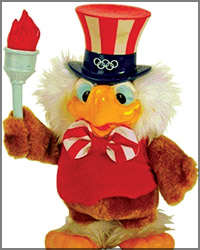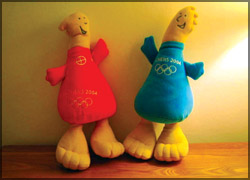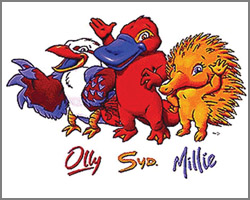
The Dazzling Mascots
Lionel Wijesiri
|

Mascots in 2008 Summer Games |
Have you ever thought how Olympics would look like without mascots?
Probably, a little less commercial and certainly a lot less fun! It’s
surprising to find out that the first official Olympic mascot was as
recent as the 1972 Munich Games. It’s been a go since then, with
sometimes as many as five mascots for a single Olympics.
Is it any wonder then, that the Beijing 2008 Olympics mascots are so
rich in symbolic meaning? After all China is a nation of living symbols.
Like the Five Olympic Rings from which they draw their colour and
inspiration, Fuwa (as they are collectively called) had served as the
Official Mascots of Beijing 2008 Olympic Games, carrying a message of
friendship and peace - and good wishes from China - to children all over
the world.
Designed to express the playful qualities of five little children who
form an intimate circle of friends, Fuwa also embodied the natural
characteristics of four of China’s most popular animals — the Fish, the
Panda, the Tibetan Antelope, the Swallow - and the Olympic Flame. Cute,
smiling and friendly, the five Olympics mascots have won the hearts of
children globally with a red, flame figure proving most popular.
Meaning
The word mascot has been traced back to a dialectic use in Provence
and Gascony in France, where it was used to describe anything which
brought luck to a household. The word was first popularised in 1880,
when French composer Edmond Audran wrote a popular comic operetta titled
La Mascotte. Audran’s operetta was so popular that it was translated
into English as The Mascot. The word with this definition was then
incorporated into many other languages.
History
Since the first mascot in Olympic history made its appearance at the
1972 Munich Olympic Games, Olympic Mascots have become a main element of
the Olympic image.
As a unique and popular image full of vitality, a mascot was able to
materialise the Olympic spirit, communicate the concepts of each Olympic
Games, promote the history and culture of the host city and create a
festive atmosphere for the Games.
Whatever shapes they have, they fundamentally share a creative
rationale, that is, the mascots must be able to convey the theme of the
Olympic Games, showcase the distinctive geographical features, history
and culture unique to the host city.
Let us browse through the Olympic Mascots of the past. Almost all of
them have interesting stories behind them.
Strategy
|

Sam in 1984 Los Angeles Summer Games |
The original purpose of an Olympic mascot was to give an extra boost
to the cultural identity of the host country. Animals native to the area
were usually picked to symbolise the Games but stylistic figures and
symbols have also been used for representation.
The mascots of the Olympic Games are probably one of the best ways
for the host city to market itself. Sure, there are official slogans,
songs and logos that brand each host city as unique but the marketing
strategy of recent Olympics rests primarily on the mascots.
|

Athena and Pheros in 2004 Athens Summer Games |
1972 - Munich Summer Games
Waldi, a long-haired dachshund, was the first official Olympics
mascot. He appeared in several flavors - his vertical stripes could
contain any three of the five Olympic colours. Waldi is very popular in
Bavaria, but he also possesses qualities which are indispensable to an
athlete: resistance, tenacity and agility. These are among the reasons
he was chosen to be the mascot.
1976 - Montreal Summer Games
It was a beaver called “Amik”, a name taken from the Algonquian
language, which is the most popular language amongst the Aboriginal
people in Canada. The beaver is the national symbol of Canada.
1980 - Moscow Summer Games
Victor Chizikov, most famous illustrator of children’s books in USSR,
designed Misha the bear, whose full name was Mikhail Potapych Toptygin.
Misha doll was used extensively during the opening and closing
ceremonies, had a TV animated cartoon and appeared on several
merchandise products.
1992 - Barcelona Summer Games
Javier Mariscal is the most highly acclaimed artist in Valencia,
Spain. It was in 1988 when Mariscal gave birth to Cobi, the funny dog
that became the mascot of the Barcelona ‘92 Olympic Games, and turned
afterwards into a cartoon character. Even today, Cobi is loved by
millions of children throughout the world for his mischievous acts.
|

Hodori in 1988 Seoul Summer Games |
1996 - Atlanta Summer Games
Izzy was probably the least successful mascot of all. No one knew
exactly what he (or she or it) was supposed to be. Originally, he was
called Whatizit or Whatizhee, and Izzy was simply a shortening of those
names. It was an amorphous abstract fantasy figure designed by the
computer.
|

Misha in 1980 Moscow Summer Games |
1984 - Los Angeles Summer Games
Designed by Walt Disney, Sam is a cartooned Eagle with sheer American
characteristics who wears the dress of the legendary American - Uncle
Sam with a star-spangled background in red, white and blue, typical
colors of USA. Commercial use of mascots was initiated henceforth.
2000 - Sydney Summer Games
Olly, Syd and Millie are three native Australian animals in
Australia. They represent earth, air and water. “Olly”, a kookaburra,
epitomises the Olympic spirit of generosity (from Olympic); “Syd”, a
platypus, represents the environment (from Sydney); “Millie”, an
echidna, is a techno-whiz and information guru. (from Millennium)
1988 - Seoul Summer Games
|

Coby in 1992 Barcelona Summer Games |
For the 1988 Olympic Games, a little tiger with typical Oriental
colour was chosen as the mascot, who was named Hodori. It portrays the
friendly and hospitable traditions of the Koreans, and the name Hodori
was chosen from the Korean word for “tiger”, and “Dori” is a diminutive
for boys in Korea.
|

Olly, Syd and Millie in 2000 Sydney Summer Games |
2004 - Athens Summer Games
The mascots, Athena and Phevos, with their whacking feet, long necks
and puny heads, are based on dolls which are thousands of years old,
found at archaeological sites in Greece. Greek mythology had it that
Phevos and Athena are brother and sister, named after two Greek gods:
Phevos and Athena, goddess of wisdom and patron of the city of Athens. |

